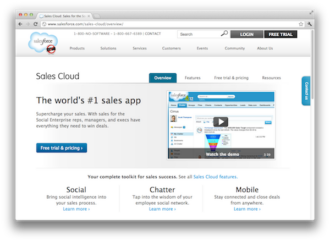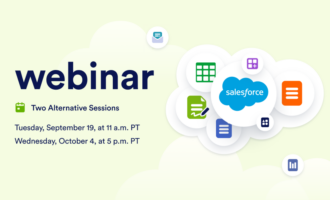Implementing Salesforce payment processing
- Choose your Salesforce payment gateway
- Install and configure the gateway
- Set up Salesforce objects
- Plug it into your website or app
In the era of e-commerce, a strong digital strategy and outstanding customer experience reign supreme. Platforms like Salesforce empower users to drive leads through marketing campaigns and move them through their funnels more efficiently than professionals in the pre-digital era could have ever imagined.
While leads won’t come through the pipeline without an effective campaign, they also won’t convert without a seamless buying experience, including at the point of payment. That’s why it’s so important to leverage Salesforce payment processing capabilities.
In addition to providing robust tools for sales, marketing, customer service management, and more, the versatile Salesforce platform also enables users to accept and manage payments. If you’re wondering why it’s so important to integrate a payment gateway in your customer relationship management (CRM) software and how you can set this up, you’ve come to the right place. Here’s everything you need to know about Salesforce payment processing.
What Salesforce does
Salesforce started out as a groundbreaking CRM platform, in many ways pioneering the world of sales automation we know today. Since then, it’s evolved into so much more, becoming a platform that seamlessly integrates sales, marketing, and customer service for an unmatched advantage in building relationships, meeting needs, and growing revenue. From this centralized hub, users can efficiently manage leads, customer data, interactions, analytics, and more. The platform provides a 360-degree view of each customer, allowing better collaboration across departments and enabling personalized engagement.
How payment gateways work
Every sales funnel has an ultimate ending: the actual purchase and exchange of money. Now, this transaction can easily take place online and via mobile devices thanks to payment gateways. They act as intermediaries between your website or app and the financial institutions exchanging funds. Here are some of the most common types of payment gateways available:
- Hosted: This type of gateway redirects customers to secure payment pages hosted by the gateway provider (such as a digital wallet company like PayPal). Customers enter their payment information on this page, and the provider processes the payment externally. Once the process is complete, customers are redirected back to your website or app.
- Self-hosted: Self-hosted gateways allow you to host the payment page on your own website. Though this method offers more control over the user experience, it also requires more investment in security and compliance. Failure to take proper precautions could cost more in the long run in regulatory fines and loss of reputation than any savings made from self-hosting.
- API-based: These gateways provide an application programming interface (API) that developers can integrate into your website or application. This is the most customizable type of payment gateway, allowing you to craft a payment experience fully in line with your brand’s aesthetics.
- Mobile: Designed for mobile apps, these gateways enable in-app or mobile web payments. Mobile payment gateways are optimized for mobile devices, providing a seamless and secure payment process.
- Cryptocurrency: Increasingly, merchants need to accept cryptocurrency as a form of payment. Fortunately, some payment gateways enable merchants to accept digital currencies like Bitcoin and Ethereum. These gateways convert cryptocurrency payments into traditional currency for settlement.
How to implement Salesforce payment processing
Salesforce is an incredibly versatile software, and developers opened it up to third parties to create their own solutions for the user community. These third-party apps are fully vetted and curated by the Salesforce team before being hosted on a platform called the Salesforce AppExchange. As a result, there are solutions available in the marketplace that allow users to add almost any kind of function or capability they want to Salesforce — including payment gateways.
Here are the general steps to setting up Salesforce payment processing:
- Choose your Salesforce payment gateway. With so many options to choose from, it’s important to select a payment gateway that aligns with your business needs and Salesforce capabilities. Some popular options compatible with Salesforce include Stripe and PayPal. (Note: Make sure that your chosen gateway supports the payment methods you want to accept.)
- Install and configure the gateway. Once you’ve chosen the payment gateway you want to use with Salesforce, follow the documentation and instructions for installation and configuration. Apps listed on the Salesforce AppExchange have all been vetted for their reliability and high quality, and they should have detailed instructions on how to complete the setup. If you run into any roadblocks, contact support for the app you’ve chosen, or feel free to ask the community.
- Set up Salesforce objects. Once the payment gateway is configured, create or configure custom objects in Salesforce to store payment-related data, payment records, customer profiles, and transaction history. This step ensures you have a structured way to manage payment data within Salesforce.
- Plug it into your website or app. Once setup is complete, you can embed the Salesforce payment gateway into a web page or app, or you can even customize a payment page for hosted payment gateways. Just be sure to test a payment before publishing.
How to improve Salesforce payment processing with Jotform
To streamline processes or create the right customer experience, sometimes it’s important to embed payment gateways directly into an online form, such as an event signup. That’s where Jotform comes in.
Jotform is a robust online form builder with over 10,000 fully customizable templates available to help users collect any kind of data. In addition to survey feedback, online quizzes, and even contract signatures, Jotform is also equipped to take payments through a variety of gateways you can embed directly in your form. Simply select the payment gateway you want added to a form and follow the instructions for setting up the integration.
Best of all, Jotform fully integrates with Salesforce through the AppExchange, enabling you to seamlessly and automatically send any information you collect from a Jotform form into your Salesforce database.
Photo by Bench Accounting on Unsplash































































Send Comment: